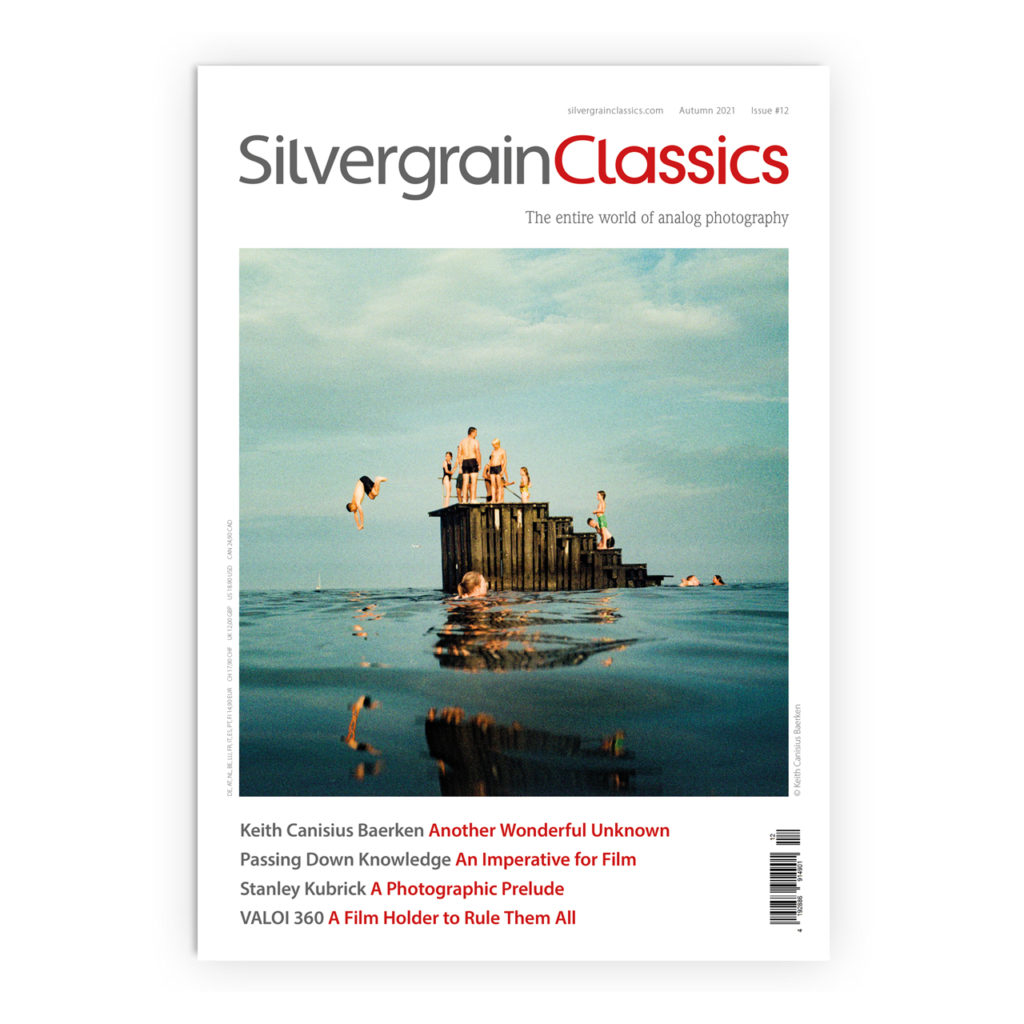The Ricoh MIRAI bridge camera
Ricoh MIRAI: Ugly Plastic or Classic Star Trek?
By Marwan el Mozayen.
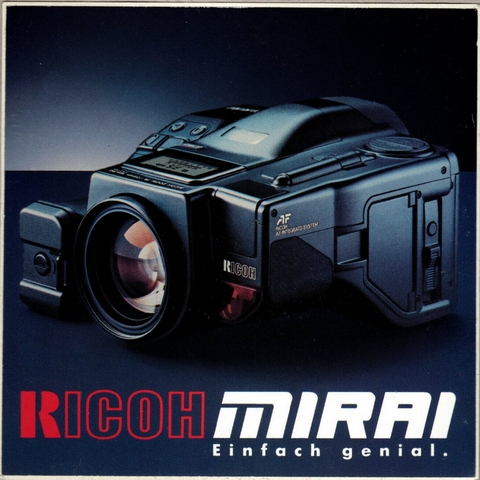
The Ricoh Mirai in an advertisement
The Ricoh MIRAI was introduced to the world in 1988. MIRAI means “future” in Japanese and moving into the future was the mission. This completely new camera class was a mixture of SLR and compact cameras. Because it bridged the gap between the two, this new type of camera was marketed as a “bridge camera”. The concept here was clear and simple. Ricoh had created a sophisticated, fully automatic SLR with a fixed AF zoom lens which ranged from wide-angle to light telephoto. The entire ensemble also had a flash and was particularly compact. The Zoom was often electronic, too. But do not be fooled. The suggestion that these cameras were pure photo robots, designed to take the photographer out of the equation, is incorrect. These cameras could also be operated in manual mode if desired.
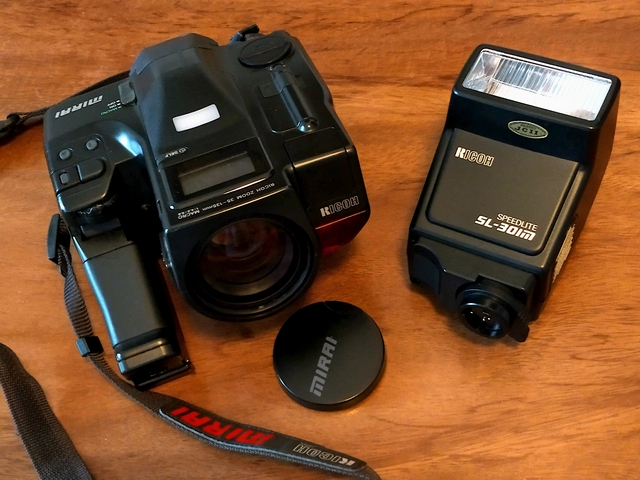
The Ricoh MIRAI was developed in partnership with Olympus and was optically very similar to Olympus’ less sonorously named AZ-4. The MIRAI was to remain Ricoh’s only SLR with autofocus due to market pressures on the small company. Before 1984 and the AF revolution, the commonly-used term for camera manufacturers was “The Big 5”: Nikon, Canon, Minolta, Pentax, and Olympus. By 1988 it had shrunk to the “Big 3” as Olympus and Pentax (along with other manufacturers like Ricoh) missed the AF train. Because the professional AF cameras of Nikon, Canon, and Minolta also required a complete range of lenses and accessories, the investment necessary to compete could not be justified. The competition in the professional arena was too strong to make launching a low-priced consumer AF camera a sensible idea. In contrast, pure consumer products were particularly lucrative; hobbyists regularly treated themselves to new devices, and if something promised innovation, it could be a good way to win back a lost market share, especially in the tech-loving ‘80s.
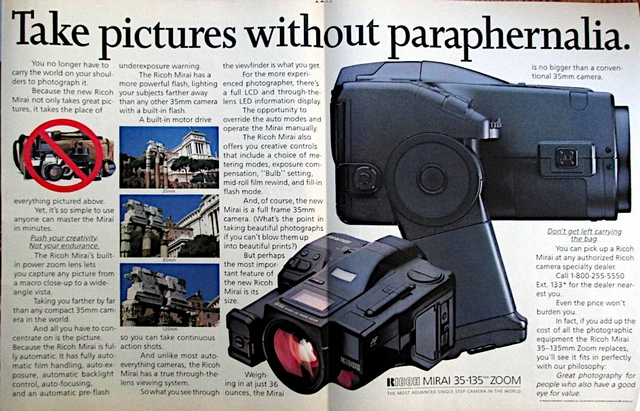
The design team of the Ricoh MIRAI camera project captured the mood of the late 80s perfectly. The typically matt black plastic body of the period could have been a creation of the Star Trek prop designer, and the camera almost looks more like an extremely compact camcorder than a 35mm AF camera. The entire design, inside and out, was intended to offer a universal tool aimed at people for whom photography was not a profession, but who demanded a certain level of quality. The MIRAI incorporated everything that other SLRs could only achieve with a lens kit.
At the time of the MIRAI’s release, accessories like an external flash, and telephoto and wide-angle converters were available to extend the focal length range, ensuring it was a serious camera with a wide range of possibilities. But the strongest feature of the camera’s concept was easy operation and good ergonomics, combined with a manufacturer’s guarantee for good photos equal to those of the big boys.
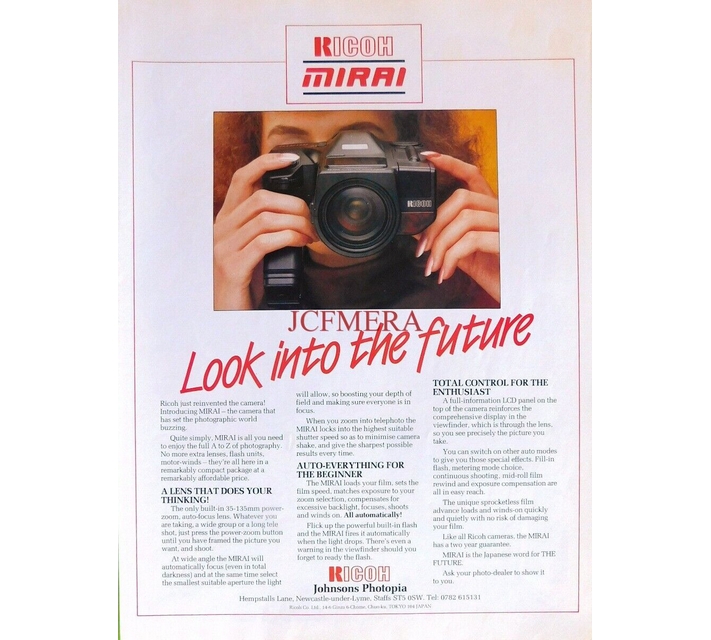
What is it like to take pictures with such a camera in 2023? Bridge cameras are easy to come by, and it is not hard to find a good specimen. Back in the 1980s, the targeted customer group was known for regularly purchasing the latest fancy schmancy item, mostly when the next major vacation or an upcoming bigger family event was about to happen. The fate of these devices was afterwards almost always the same. Only a few rolls of film were exposed, and the device was then forgotten in its camera bag in the living room closet. At apartment liquidations, this equipment then reappears. The specimen I bought at the auction seems to have had exactly such a life. Delivered to me in a camera bag with all accessories I found in the side pockets all manuals, as well as the purchase receipt. There were unfortunately batteries in the camera, and they were now leaking. Fortunately, only the contacts were dirty and after a thorough cleaning, the old Ricoh could be switched on without any problems. The camera takes Lithium CR-P2 type or easy-to-find 4 x AAA batteries.
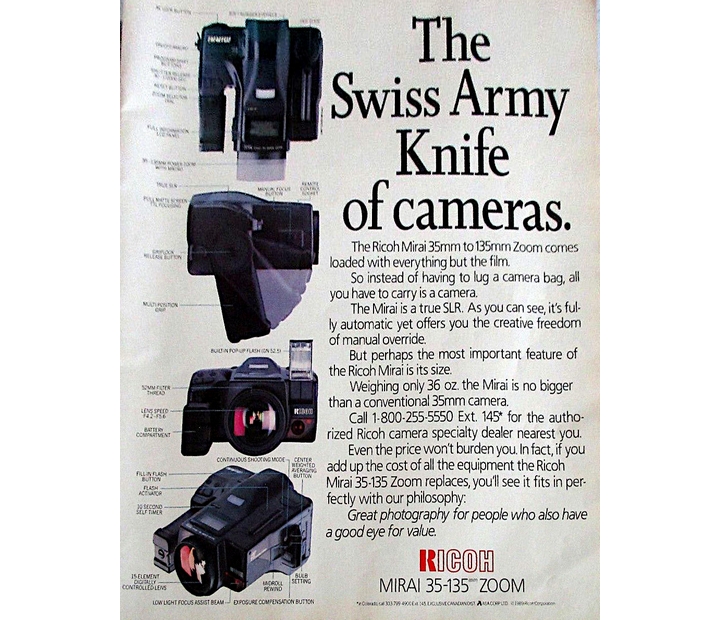
When the MIRAI is switched on, it always performs a start-up ceremony. The lens extends a bit further and internally in its body the noises give the impression that an army of small servo motors and gears seems to prepare the camera for its use. The film insertion happens fully automatically with a similar soundscape. Assuming you have inserted a film cartridge with DX coding, you can now start taking pictures. This happens completely intuitively and doesn’t need any explanations. You can easily control the focal length with the right index finger, aim at the object to be focused, press the shutter button to the first pressure point to save the setting, correct the crop and finally release the shutter. That was it. Of course, there are plenty of other functions that can be individually controlled via buttons and dials. The user manual must be studied to use these additional functions.
All in all, the Ricoh MIRAI is fun to use and fits very well in the hand thanks to the especially adjustable grip. The focal range is perfect for on-the-go or at parties and events. With the additional flash, you have a full-fledged reportage-capable SLR.
The MIRAI is not a real beauty like a Leica M3 or a classic Nikon F or other cameras from the metal era but it is fast and practical. The camera is really well made and very robust and the plastic body can easily take a knock. If the camera is treated a little roughly, it’s not so valuable that you have to worry if the camera ends up getting damaged.
The 35 mm – 135 mm zoom lens is a bit slow with F4.2 – F5.6, but with a 200 or 400 film in everyday use, this is not a problem. The AF System is quite fast and accurate.
I own the camera now for more than 1 year and use it from time to time and I am always surprised by the ingenious simplicity of the operation as well as the really good pictures that the MIRAI produces. If you are purely interested in taking good photos, you can create fantastic images with this camera for very little money. Therefore, the MIRAI gets my full recommendation!
Technical Specifications
Lens
Zoom Range: 35 mm – 135 mm
Lens Speed: F4.2 – F5.6
Minimum Focusing Distance: 1.2 m
Macro Distance: 1.2m – 0.49 m (by Focus Aid)
Macro Magnification: 1/4.9 (at 0.49m)
Macro Type: Tele Macro
Filter Size: 52 mm
Front Lens Diameter: 44 mm
Lens Construction: 15 Elements in 13 Groups
Lens Retraction: By 8 mm (When Main Switch is Off)
Zooming: Power Zooming
Viewfinder
Type: TTL Type
Magnification: × 0.80 (at 50 mm)
Field of Coverage: 87%
Screen Information: Matt Only (Not Interchangeable) with AF Frame; In Focus, Too Far, Too Close, Strobe Charge (by LEDs) F-Stop; Shutter Speed (pulsates as slow shutter warning), Exposure Over, Under, AE Lock, Macro, Exposure Compensation
Light Measurement
Mode: Automatic Back Light Control Mode; Center-Weighted Average Mode
AE Lock: Yes
Exposure Compensation: + or – 4EV
EV Range: EV4-20
ISO Setting: 25 – 5000
Focusing
Type: TTL Automatic Focusing Single AF Type
AF Distance Coverage: 1.2 m – inf.
AF Range: EV4 – 17 (without Beam Illuminator)
Beam Illuminator: Automatically lights in low light up to about 5.5 m
Focus Aid: Possible by Power Focusing; at Macro Mode Use Focus Aid for AF
Exposure
Mode: Program AE with Automatic Shift Capability (35 – 44 mm: Wide, 45 – 70 mm: Standard, 71 – 135 mm: Tele Program); Manual Program Shift Possible with Up/Down Button Bulb
Strobe
Type: Flash Matic Type Built-in
Shooting Range: Wide: 1.2 – 5 m/Tele: 1.2-4.0m (ISO 100 Negative Film)
Pop-up: Manual Pop-up
Sensor: Yes When Popped-up
Fill Flash: Possible by Fill-Flash Button
Strobe Effective Range: Can be checked before Shooting
Additional Strobe: Can be attached (G. NO. 30)
Synchro Speed: 1/100 sec.
Shutter
Type: Focal Plane Type
Speed: 32 sec. – 1/2000 sec. and Bulb
Outside LCD Panel
Focusing Distance, Focal Length, Film Loaded, Film Set, Continuous Winding, Average Metering, Self Timer, Fill Flash, Exposure Counter Battery Condition
Control Buttons
Covered: Exposure Compensation, Manual Rewind, BLC/Average, Bulb/Auto Exposure, Single/Continuous Winding
Others
Remote Control Socket: Yes
Databack: Can Be Attached
Self-timer: 10 Seconds
Battery: Lithium (CR-P2), or AAA × 4
Size: 135 mm (W) × 126 mm (D) × 81 mm (H)
Weight: 1010 g
You can read more about the Ricoh MIRAI at https://www.ricoh-imaging.co.jp/japan/products/ricoh-filmcamera/cameralist/MIRAI.html
You might also be interested in this article where we test Harman’s new Kentmere 100 film in 120 format. https://silvergrainclassics.com/en/2023/01/kentmere-100-fashion-fetish-film/
You can find an index to the entire collection of SilvergrainClassics magazines here https://silvergrainclassics.com/en/magazine/index-of-articles/

